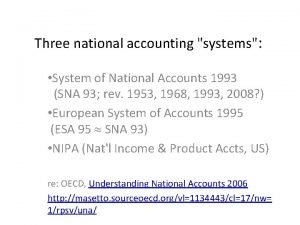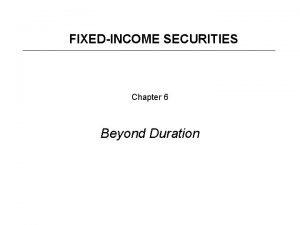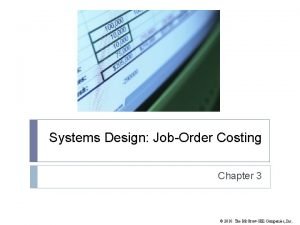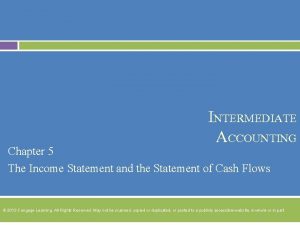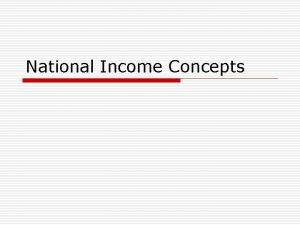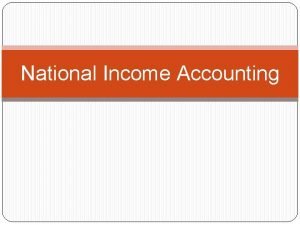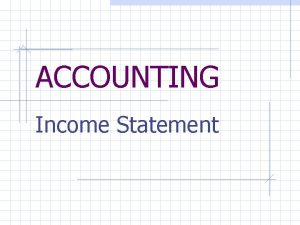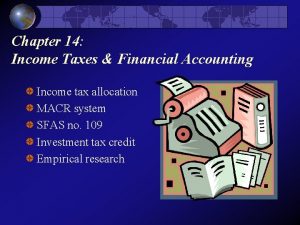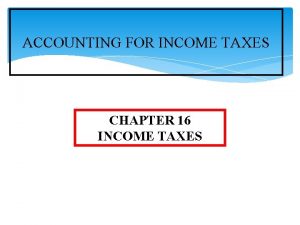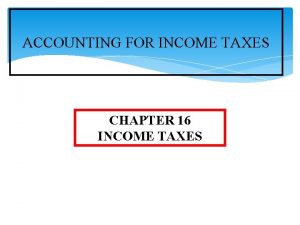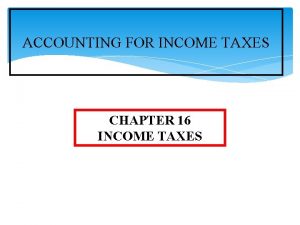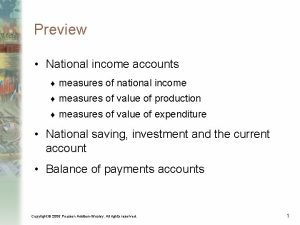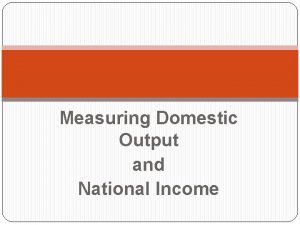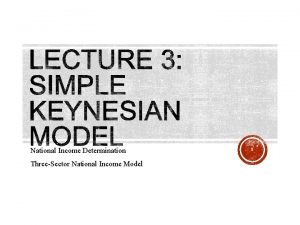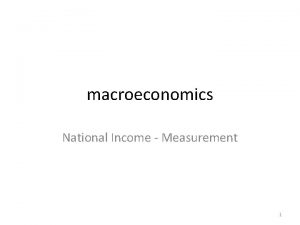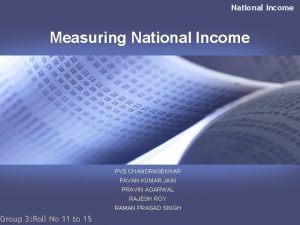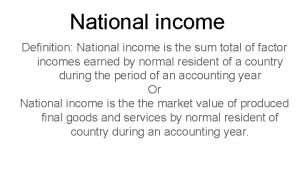Chapter 12 National income accounting a system that


























- Slides: 26

Chapter 12 • National income accounting: a system that collects macroeconomic statistics on production, income, investment, and savings Chapter 12 Section Main Menu

What Is Gross Domestic Product? • $ value of all final goods and services produced within a country’s borders in a given year. Chapter 12 Section Main Menu

Calculating GDP The Expenditure Approach The Income Approach • Calculates GDP by adding • Calculates GDP by up amounts spent on final adding up all the incomes goods and services. in the economy. Durable, Non-Durable and Services C= Consumer Spending I= Business Investment G=Government • Incomes that firms pay households for the factors of production they hire- wages for labor, interest for capital, rent for land profits for entrepreneurship. X=Net Exports M= Imports GDP = C + I + G + (X-M) Chapter 12 Section Main Menu

GDP Does not include the value of the following: • Intermediate goods (components of the final good). Ford buys batteries/tires for their cars • Second Hand Sales – boots produced in 1998 are bought in a thrift in 2012 • Purely Financial Transactions – stocks, bonds, CD’s (no contribution to • Transfer Payments – welfare, unemployment, social security • Unreported Legal Business Activity – I’m a waitress, and don’t report my tips, self-employed. Approx. 600 billion • Illegal Business Activity – murder for hire, prostitution, drugs, gambling. Approx. 300 billion final production) Chapter 12 Section Main Menu

Limitations of GDP • GDP fails to measure or express changes in the following: Income Distribution Negative Externalities Quality of Life Chapter 12 Section Main Menu

Real and Nominal GDP • Nominal GDP is GDP measured in current prices. It does not account for price level increases from year to year. Chapter 12 Section • Real GDP is GDP expressed in constant dollars. It accounts for inflation. – More accurate depiction of GDP Main Menu

Nominal vs. Real GDP Example 1. Avatar (2008) $742, 721, 000 2. Titanic (1997) $600, 779, 824 3. Star Wars (1977) $460, 935, 665 4. Shrek 2 (2004) $436, 471, 036 5. E. T. : The Extra-Terrestrial (1982) $434, 949, 459 6. Star Wars: Episode I - The Phantom Menace (1999) $431, 065, 444 7. Pirates of the Caribbean: Dead Man's Chest (2006) $423, 032, 628 8. Spider-Man (2002) $403, 706, 375 9. Star Wars: Episode III - Revenge of the Sith (2005) $380, 262, 555 10. The Lord of the Rings: The Return of the King (2003) $377, 019, 252 11. Spider-Man 2 (2004) $373, 377, 893 Chapter 12 Section Main Menu

Tickets Sold 1. Gone With the Wind 283, 100, 000 2. Snow White & the Seven Dwarfs 225, 300, 000 3. Star Wars 176, 900, 000 4. E. T. : The Extra-Terrestrial 158, 000 5. 101 Dalmations 143, 100, 000 6. Bambi 140, 800, 000 7. Titanic 130, 900, 000 8. Jaws 128, 600, 000 9. The Sound of Music 119, 300, 000 The Ten Commandments 2 117, 800, 000 10. Chapter 12 Section Main Menu

Nominal vs. Real GDP Example DOMESTIC GROSSES Adjusted for Ticket Price Inflation* Rank Title (click to view) Studio Adjusted Gross Unadjusted Gross Year^ 1 Gone with the Wind MGM $1, 390, 067, 000 $198, 676, 459 1939^ 2 Star Wars Fox $1, 225, 462, 800 $460, 998, 007 1977^ 3 The Sound of Music Fox $979, 817, 800 $158, 671, 368 1965 4 E. T. : The Extra-Terrestrial Uni. $975, 957, 800 $435, 110, 554 1982^ 5 The Ten Commandments Par. $901, 280, 000 $65, 500, 000 1956 6 Titanic Par. $883, 019, 700 $600, 788, 188 1997 7 Jaws Uni. $881, 182, 300 $260, 000 1975 8 Doctor Zhivago MGM $854, 051, 900 $111, 721, 910 1965 9 The Exorcist WB $760, 712, 400 $232, 671, 011 1973^ 10 Snow White and the Seven Dwarfs Dis. $749, 920, 000 $184, 925, 486 1937^ 11 101 Dalmatians Dis. $687, 430, 700 $144, 880, 014 1961^ 12 The Empire Strikes Back Fox $675, 482, 800 $290, 475, 067 1980^ Chapter 12 Section Main Menu

Measuring Economic Growth Real GDP per capita • Real GDP / total population. • Considered the best measure of a nation’s standard of living. • Current GDP per capita in US is about 49, 601 in China it is about 5, 000. Why? • Current US GDP per capita: 49, 601 • Current US GDP: $15. 685 trillion (2012) • Current US Population: 311, 591, 917 Chapter 12 Section Main Menu

GDP vs. GDP Per Capita • http: //en. wikipedia. org/wiki/List_of_countries_by_GDP_ (nominal)_per_capita • http: //en. wikipedia. org/wiki/List_of_countries_by_GDP_ (nominal) Chapter 12 Section Main Menu

Other Income and Output Measures Gross National Product (GNP) • Market value of all goods and services produced by Americans in one year. Chapter 12 Section Main Menu

What Is a Business Cycle? A macroeconomic period of expansion followed by a period of contraction. Chapter 12 Section Main Menu

Phases of the Business Cycle Expansion • Period of economic growth as measured by a rise in real GDP. 1990’s – Longest period of growth in American history Peak • When real GDP stops rising; the height of its economic expansion. Contraction • An economic decline marked by a fall in real GDP. – Recession (real GDP falls 6 consecutive months) – must also take into account unemployment, interest rates, etc… – Depression Trough • Lowest point of economic decline, when real GDP stops falling. Chapter 12 Section Main Menu

Business Cycle – Last 40 years Chapter 12 Section Main Menu

What Keeps the Business Cycle Going? • Four main economic variables: Business Investment Interest Rates and Credit Consumer Expectations External Shocks Chapter 12 Section Main Menu

Chapter 12 • Depreciation-The loss of the value of capital equipment that results from normal wear and tear • Price Level- the average of all prices in the economy • Aggregate supply- the total amount of goods and services in the economy available at all possible price levels • Aggregate demand- the amount of goods and services in the economy that will be purchased at all possible price levels Chapter 12 Section Main Menu

Chapter 12 • Trough- the lowest point in an economic contraction, when real GDP stops falling • Recession- a prolonged economic contraction • Depression- a recession that is especially long and severe • Stagflation- a decline in the real GDP combined with a rise in the price level • Leading indicators- key economic variables that economists use to predict a new phase of a business cycle Chapter 12 Section Main Menu

Chapter 12 • Real GDP per capita- real GDP divided by the total population • Capital deepening- process of increasing the amount of capital per worker • Saving-income not used for consumption • Savings rate- the proportion of disposable income that is saved • Technological process- an increase in efficiency gathered by producing more output without using more inputs Chapter 12 Section Main Menu

Forecasting Business Cycles • Leading indicators are key economic variables economists use to predict a new phase of a business cycle. - Stock Market - Interest Rates Chapter 12 Section Main Menu

Business Cycle Fluctuations The Great Depression 1929 -1932 - Industrial Production -46% - Unemployment 25% - 1 out of 4 didn’t have a job Later Recessions Chapter 12 Section Main Menu

Measuring Economic Growth Real GDP per capita • It is a measure of real GDP divided by the total population. • Real GDP per capita is considered the best measure of a nation’s standard of living. • Current US GDP per capita: 46, 859 • Current US GDP: 14. 2 trillion • Current US Population: 307, 212, 123 Chapter 12 Section Main Menu

Capital Deepening • The process of increasing the amount of capital per worker is called capital deepening. Capital deepening is one of the most important sources of growth in modern economies. Chapter 12 Section • Firms increase physical capital by purchasing more equipment. Firms and employees increase human capital through additional training and education. Main Menu

The Effects of Savings and Investing • The proportion of disposable income spent to income saved is called the savings rate. • When consumers save or invest, money in banks, their money becomes available for firms to borrow or use. This allows firms to deepen capital. How Saving Leads to Capital Deepening Shawna’s income: $30, 000 $25, 000 spent $3, 000 in a mutual fund (stocks and corporate bonds) • In the long run, more savings will lead to higher output and income for the population, raising GDP and living standards. Chapter 12 Section $5, 000 saved $2, 000 in “rainy day” bank account Bank lends Shawna’s Mutual-fund firm makes money to firms in forms Shawna’s $3, 000 such as loans and available to firms mortgages Firms spend money on business capital investment Main Menu

The Effects of Technological Progress • Besides capital deepening, the other key source of economic growth is technological progress. • Technological progress is an increase in efficiency gained by producing more output without using more inputs. • A variety of factors contribute to technological progress: – Innovation When new products and ideas are successfully brought to market, output goes up, boosting GDP and business profits. – Scale of the Market Larger markets provide more incentives for innovation since the potential profits are greater. – Education and Experience Increased human capital makes workers more productive. Educated workers may also have the necessary skills needed to use new technology. Chapter 12 Section Main Menu

Other Factors Affecting Growth Population Growth • If population grows while the supply of capital remains constant, the amount of capital per worker will actually shrink. Government • Government can affect the process of economic growth by raising or lowering taxes. Government use of tax revenues also affects growth: funds spent on public goods increase investment, while funds spent on consumption decrease net investment. Foreign Trade • Trade deficits, the result of importing more goods than exporting goods, can sometimes increase investment and capital deepening if the imports consist of investment goods rather than consumer goods. Chapter 12 Section Main Menu
 Carrying amount formula
Carrying amount formula Loss contingency journal entry
Loss contingency journal entry Value added approach formula
Value added approach formula Ano ang expenditure approach
Ano ang expenditure approach Gnp vs gdp
Gnp vs gdp Phân độ lown
Phân độ lown Block xoang nhĩ
Block xoang nhĩ Thể thơ truyền thống
Thể thơ truyền thống Thơ thất ngôn tứ tuyệt đường luật
Thơ thất ngôn tứ tuyệt đường luật Walmart thất bại ở nhật
Walmart thất bại ở nhật Tìm độ lớn thật của tam giác abc
Tìm độ lớn thật của tam giác abc Con hãy đưa tay khi thấy người vấp ngã
Con hãy đưa tay khi thấy người vấp ngã Tôn thất thuyết là ai
Tôn thất thuyết là ai Gây tê cơ vuông thắt lưng
Gây tê cơ vuông thắt lưng Sau thất bại ở hồ điển triệt
Sau thất bại ở hồ điển triệt Tax loss carry forward
Tax loss carry forward What is included in statement of comprehensive income
What is included in statement of comprehensive income Systems of national accounts
Systems of national accounts Economics subject
Economics subject Financial accounting and accounting standards chapter 1
Financial accounting and accounting standards chapter 1 Income statement in financial accounting
Income statement in financial accounting Income accounting u of u
Income accounting u of u Fixed income accounting
Fixed income accounting Cost accounting income statement
Cost accounting income statement Multi step income statement
Multi step income statement Asc 740
Asc 740 National income formula
National income formula

















